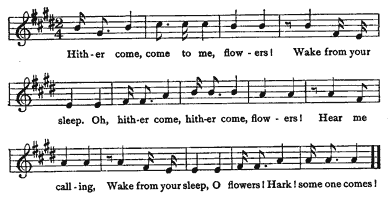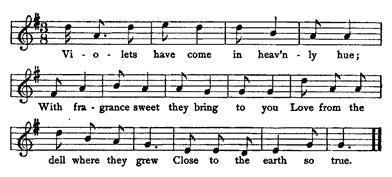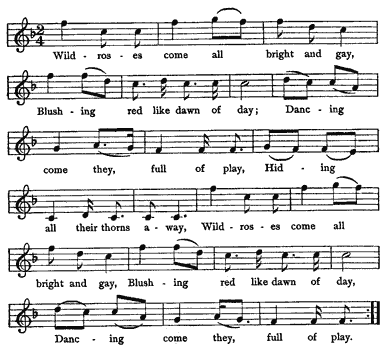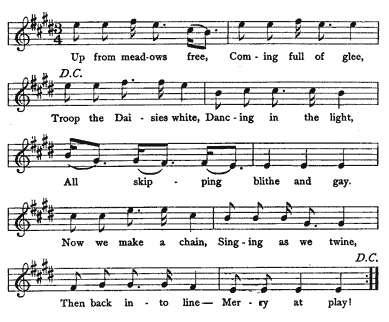Calling the Flowers
by Alice C. Fletcher
INTRODUCTORY NOTE.—This dance is derived from a ceremony, observed among the Indians of the North Pacific Coast, in which the spirits dwelling beneath the ground are called to come and join those who are dancing. The dancer who calls the spirits moves with gliding steps, the arms outstretched, the hands beckoning upward in a gentle, enticing manner. The grace, dignity and earnestness of this dance linger with the writer as a beautiful memory after the lapse of many years.
Properties.—A green scarf for the Caller. Blue, white and rosy scarfs for as many dancers as will personate the three Flowers that respond to the call: Violets, Wild-roses and Daisies. A twisted rope of green to link the dancing Flowers together in the final dance.
Directions.—A clear space will be required large enough for all the dancers to move about in the final dance. Those who personate the Flowers should be hidden from view until the time when they are to respond to the call. In the properties enumerated above, mention is made only of scarfs. The picturesqueness of the dance would be enhanced if the dancers wore headdresses shaped somewhat like the flowers and made of appropriate colored paper; blue or lilac for the Violets, with a touch of yellow; deep pink or pale red for the Wild-roses, with a little yellow for the stamens; white with yellow for the Daisies. The twisted rope of green paper should be made over heavy twine, so as to be strong enough for the dancers to grasp in the final dance. All these decorative articles should be made in the camp.
The dancer who acts as the Caller should wear the green scarf loosely thrown about the head and body. If the voice of this dancer is not strong enough to be clearly heard by those who look on at a little distance, then two other persons should stand one at each side of the open space and sing with the dancer who is the Caller. These two extra singers should be wrapped in green scarfs and stand quietly as interested spectators while the dancer calls. Care should be taken to give the words of the songs with clearness and distinctness, so that every person within hearing distance can catch them easily.
The Dance
The scene opens with the one who is to call the Flowers standing in the center, looking about in different directions. Suddenly, as if the thought occurred to call for companions, the following song is begun:
Song No. 1
Call to the Flowers
Hither come, come to me, flowers!
Wake from your sleep.
Oh, hither come, hither come, flowers!
Hear me calling,
Wake from your sleep, O flowers!
Hark! some one comes.

With the song, movement begins. The steps taken should be gentle and gliding, the arms outstretched as in entreaty, the hands moved as in beckoning, not with one finger but all the fingers slowly bending toward the open palm. The dancer should think what the action means as she glides about the open space, and strive to carry out the picture of awakening the sleeping flowers, of bidding them to "come hither." It is possible that more time may be required by some dancers to produce the picture than merely singing the song once through would give; in that case, that portion of the song having the words "Hear me calling, Wake from your sleep, O flowers!" can be repeated once or twice, to meet the requirements of the dancer. The last line, "Hark! some one comes!" should be given with dramatic action.
These words are the cue for those who are to represent the Violets to prepare to enter from different points on the right, and to make a soft, stirring sound before they come into view, singing the following song:
Song No. 2
Song of the Violets
Violets have come in heav'nly hue; With fragrance sweet they bring to you Love from the dell where they grew Close to the earth so true.

The Violets dance with quiet steps in rhythm with the song. They slowly advance and gather in a loose circle about the Caller, whom, as they come near, each one lightly touches, to give "Love from the dell where they grew." Then they retire to the edge of the open space at the right and sit on the ground in little groups. When they are quiet and in their places, the Caller moves toward them, then turns, stops, looks at the empty side at the left and sings:
Song No. 1
Call to the Flowers
The last line gives the cue to those who represent the Wild-roses to make a rustling sound where they are hidden on the left. They enter with light springing steps, singing:
Song No. 3
Song of the Wild-Roses
Wild-roses come all bright and gay, Blushing red like dawn of day; Dancing come they, full of play, Hiding all their thorns away. Wild-roses come all bright and gay, Blushing red like dawn of day, Dancing come they, full of play.

The Wild-roses dance about gaily; they circle the quiet little clumps of Violets that remain seated. The Wild-roses frolic around the Caller, capering about in wild freedom but keeping their steps in exact time with their song. Finally they pause in groups at the left.
After a moment, the Caller moves toward the rear of the open space and while there once again sings:
Song No. 1
Call to the Flowers
At the close of the song the dancers who are to represent the Daisies give a trilling shout and appear from the rear of the open space, skipping; their leader holds the end of a long green rope, which is caught hold of by each dancer who follows, all singing:
Song No. 4
Song of the Daisies
Up from meadows free,
Coming full of glee,
Troop the Daisies white,
Dancing in the light,
All skipping blithe and gay.
Now we make a chain,
Singing as we twine
Then back into line—
Merry at play!

As the Daisies skip in the open space, the dancers are widely separated as they hold on to the rope; at the words "Now we make a chain" the Violets, who had risen as the Daisies entered, move toward the string of dancers; the Wild-roses also come toward the chain and grasp the green rope. The colors of the flowers should alternate and all the Flowers should have hold of the rope and cling to it as to a great green stem. Then all circle around the Caller, who is the last to grasp the stem. As all the Flowers dance they repeat Song No. 4, beginning at the words "Troop the Daisies white," etc.
This chain of flowers should make, as they dance, interweaving figures. These can be left to the fancy of the dancers, but just what they are to be must be decided upon beforehand and rehearsed; otherwise the dance will not be successful and pleasing.
The dances for each kind of flower will require practice, for the character of each flower should be well brought out; the gentleness of the Violets can make a charming contrast to the waywardness of the Wild-roses and the pliant Daisies who are at home everywhere.